Frederick III of Aragon, King of Sicily (1296–1337). Frederick III of Aragon was the third king of the Aragonese dynasty on the throne of Sicily. He ruled from 1296 to 1337 and he was the only Aragonese king of Sicily who made a significant use of his image. In particular, we have four official (namely, commissioned directly by him or his entourage) representations of him: the royal seal, the billon silver denaro coin, the lost mosaic from the Church of Santa Maria della Valle (known as Badiazza) near Messina, and the mosaic in the Cathedral of Messina.
- royal images
- royal iconography
- kings of Sicily
- Aragonese dynasty
- Frederick III of Aragon
1. Introduction
Notwithstanding he already ruled as vicar of his brother James II from 1291, only in 11 December 1295 was Frederick III of Aragon elected King of Sicily by the Sicilian Parliament. Afterwards, he was crowned in Palermo on 25 March 1296 and he reigned until his death in 25 June 1337 (about Frederick III of Aragon, King of Sicily, see [1–4][1][2][3][4], the update [5] and synthetically [6–8][6][7][8]. More recent but not particularly interesting are [9–11][9][10][11]. For a historiographical framework on Frederick III, see [12], [13] (pp. 183–211)). Among the kings of the Aragonese dynasty on the Sicilian throne, Frederick III seems to be the only one who made significant use of his image and, for this reason, he has been selected to represent the iconography of this royal family (we do not know of any images of Peter III of Aragon acting as King of Sicily. The lost wall paintings of the Cappella di Santa Maria Incoronata in Palermo date back to the 16th century [14] and it does not seem that he made a specific seal for the Kingdom of Sicily by only using the seal of king of Aragon [15] (Volume 1, pp. 115–117 and 207–208). With regard to James II of Aragon acting as King of Sicily, we only have the images of the seal [15] (Volume 1, p. 8 and pp. 240–241, no. 187), [16] (p. 82, although the reference should be corrected) and the denaro [17] (p. 10), [18] (p. 264 and pp. 696–697, plate 42, images no. 769–770)). Regarding him, we have four official (namely, commissioned directly by him or his entourage) representations: the royal seal, the billon silver denaro coin, the lost mosaic from the Church of Santa Maria della Valle (known as Badiazza) near Messina, and the mosaic in the Cathedral of Messina (about the identification of Frederick III’s official image, see [19]).
2. The Royal Seal
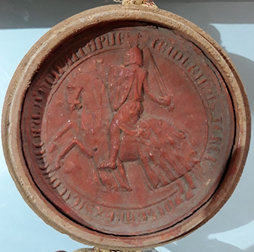
Figure 1. Seal of Frederick III of Aragon as King of Sicily, impression on red wax, 15 October 1299. Museo Civico di Caltagirone (ex Carcere Borbonico), section Pergamene della Universitas di Caltagirone, inventory number MC 4910, 10/22 1997. Photo taken by author.
3. The Denaro
Among the official representations of Frederick III, there is also the image of the billon silver denaro minted in Messina (Figure 2) (about this image, see [17] (p. 15 and image in plate 2, no. 36), [18] (pp. 267–268, p. 698 and plate 43, images no. 780–782)). Its function was mainly legal: It was used in order to corroborate the legal value of the coinage. On the obverse of this coin is the legend + FRI • T • DEI • GRA (namely, Fridericus tertius Dei Gratia), with the crowned head of the king turned to the left encircled in small pearls. He has long hair and, probably, a shaved face. The reverse displays the inscription + REX: SICILIE: and a cross pattée again encircled by small pearls. We do not know whether it continued to be issued during the years when the king adopted the title of Rex Trinacrie (namely, from 1311 to 1314 and from 1319 to 1320) (about the Frederick’s different royal titles, see again [13] (pp. 191–192)). However, it is plausible that it circulated for all the years of Frederick III’s rule. The iconography of this coin is really generic and stereotyped and it is difficult to say whether it was following a specific tradition. However, we can argue that Frederick III again adopted an Aragonese pattern. Indeed, the image of this coin is very similar to that of the denaro of his brother and predecessor James II (about James II’s denaro, see [17] (p. 10 and image in plate 1, no. 17), [18] (p. 696 and plate 42, images no. 769–770)).
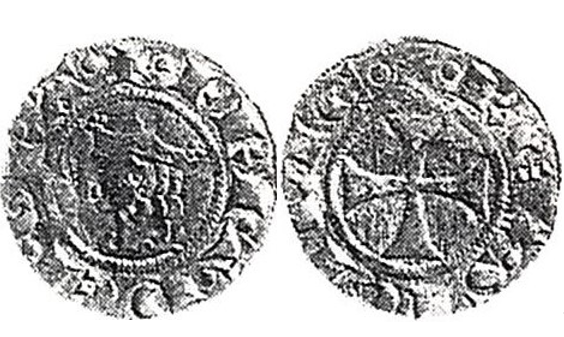
Figure 2. Denaro of Frederick III of Aragon, King of Sicily, obverse and reverse of billon silver coin, 1296–1337. Reproduced with permission of the Licensor. Image published in [18] (plate 43, image no. 780).
Certainly, on a coin, the royal image could move around the entire kingdom (that is, the island of Sicily and part of Calabria) and the lesser worth of a silver coin in comparison to a gold coin would have made its use more widespread. Moreover, we know that probably around 1315, Frederick III implemented a monetary policy to place stricter royal control on the circulation and actual quality of the currency (about that, see [11] (pp. 87–88)). In addition, he ordered an abundant amount of silver coins to be minted while at the same time limiting the minting of gold coins (about that, see [17] (p. 11), [18] (pp. 265–268 and for more general information pp. 257–260)). Considering that the former also included the denari with the king’s head (for an overview of Frederick III’s coins, see [17] (pp. 12–16), [18] (pp. 265–268, pp. 696–699 and plates 42–43, images no. 771–782)), the possibility of coming across the royal image would have been quite high. Nevertheless, coins could be hoarded and, moreover, anthropologists have noted that in general, when coins are used, more attention is placed on their economic worth than their images. Furthermore, we have to consider that this denaro did not have a particularly great visual or emotional impact: It is very small (the diameter is only 16 mm and the weight is 0.58–0.65 g) and it has a certain iconographical inaccuracy and stylization that makes it difficult to identify the subject that is represented.
4. The Mosaic of the Church of Santa Maria Della Valle in Messina
The Church of Santa Maria della Valle, also called della Scala or Badiazza, with the connected convent of Benedictine nuns (these days, the congregation is almost nil) is in Contrada Badiazza near Scala, in a mountainous area along the San Rizzo stream, approximately three miles from the center of Messina (about this church, see [27] (pp. 51–60), [28] (pp. 3–8), [29], [30] (pp. 256–258), [31,32][31][32]). The current building, probably constructed on pre-existing remains, goes back to the end of Norman domination or to the beginning of Swabian rule. In particular, Giuseppe Agnello proposed dating it to the first quarter of the 13th century [33], [34] (pp. 247–284). However, following a fire during the Sicilian Vespers (1282), Frederick III ordered the church to be restored and redecorated (and maybe also extended) in the first decade of the 14th century. It was during this work that, following the assertion of Placido Samperi in 1644, the king had a portrait of himself made in a mosaic in the main apse (Figure 3) in the act of offering, together with his wife, a model of the church to Saint Peter (“Hebbe in molta veneratione questo luogo Federico II d’Aragona Rè di Sicilia, et ingrandì quel Monasterio, et edificò quel Tempio, con bellissima architettura, ornando la Tribuna maggiore, con ricco Mosaico, ove egli dipinto si vede riverentemente à piè del Vicario di Christo S. Pietro Apostolo, con la Regina sua moglie, e tiene il modello del Tempio, e Monasterio nella man destra in atto di presentarglielo” [35] (p. 317)).
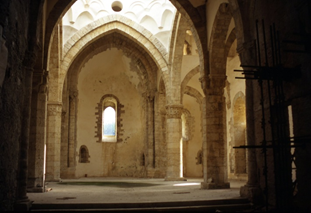
Figure 3. Church of Santa Maria della Valle (called Badiazza), central apse. Image courtesy of https://www.cistercensi.info/abbazie/abbazie.php?ab=1165 (accessed on 20 May 2021).
5. The Mosaic of the Cathedral of Messina
Guidotto de Abbiate (and not de Tabiatis) (about that, see [46]), archbishop of Messina from 1304 to 1333, ordered a series of completions and improvements to the Cathedral of Santa Maria la Nuova in Messina: decoration of the main facade (left portal) and sacristy, encouragement for private citizens to build chapels and altars, erection of his funeral monument, and the construction, on the north side of the church, of new structures for the clergy (about the Cathedral of Messina, see [47], [30] (pp. 253–255), [48]). However, for our purposes, the most relevant endeavor is the decoration of the main apse with mosaics (Figure 4). It included a medallion with angels on the extrados, eight images of the Elders per side (Ap. 4:4), the Agnus Dei on the intrados in the middle, and the Etimasia and Christ enthroned and flanked by two seraphs, two angels, the Virgin, and Saint John the Baptist on the apse basin. Here, at the feet of Christ, small figures of Archbishop Guidotto, Frederick III of Aragon, and his son Peter II (identified respectively by the inscriptions GUIDOTUS ARCHEP[ISCOPU]S / FRIDERICVS REX / PETRVS REX) were depicted in the act of devotion (about this decoration, see [49] (Volume 2, p. 159), [47] (pp. 26–36), [50] (p. 319), [51], [48] (pp. 277–278), [52–56][52][53][54][55][56]). Later on, the side apses were also decorated with mosaics. The left (SS. Sacramento) has an image of the Virgin on the throne with the Child while the Hand of God (from the Heavens) is blessing her. Archangels Michel and Gabriel and saints Agatha and Lucy come up beside her while queens Eleanor of Anjou (wife of Frederick III as of 1302) and Elisabeth of Carinthia (wife of Peter II as of 1322) are at her feet. The right (S. Placido) has the image of Saint John the Evangelist. Saints Nicholas and Basil come up beside him while Louis of Aragon and John, Duke of Randazzo (regent of the Kingdom of Sicily from 1342 to 1348), are at his feet]. The king has a kneeling position, long hair, and shaved face and he wears a crown with pendilia, a loros, a red tunic, and a purple cloak with geometric decorations (maybe stylized stars). His iconography probably follows a Norman tradition (for more information and details about the iconographic tradition of the images of Frederick III, see [57]).
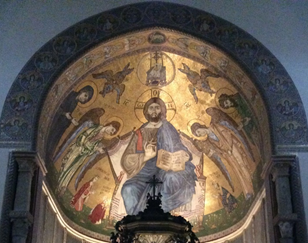
Figure 4. Cathedral of Messina, central apse with mosaic decoration rebuilt after the bombing on 13 June 1943. Photo taken by author.
Considering that Frederick III is also portrayed here as praying, historians think that the king played a preponderant role in the commission of this work. For this reason, we can consider this image in some sense to be an official representation of the sovereign (moreover, do not forget that Frederick III often resided in Messina and he made this city the de facto capital of his kingdom in place of Palermo [4] (pp. 88–89), [58]). Regarding the dating, we can assume that the work was finished by the death of Guidotto in 1333 and that its conception and creation began after 1321, when Frederick III admitted his son Peter II to the throne of Sicily (here he is being presented with the royal title) (for a summary of this event, see [6]). However, over the centuries, the Cathedral of Messina has suffered a lot of damage and its mosaic has undergone intense restoration, in some cases being remade from scratch (about that, see [51–56]). The earthquake on 28 December 1908 did not particularly harm the main apse but the fire provoked by the bombing on 13 June 1943 produced much more serious damage. Following the report written during the survey conducted after the collapse, the image of Frederick III was fortunately still “intatta” [53] (p. 602), however it was decided to completely rebuild all of the decoration of the apse. For this reason, what we can currently admire is the result of this remake (which, it seems, also covered the original remains).
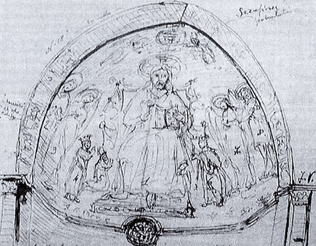
Figure 5. Graphic survey of the mosaics of the central apse of the Cathedral of Messina after the 1943 fire. Palermo, Biblioteca Comunale, Valenti Photographic Archives. Reproduced with permission of the Licensor. Detail of the image published in [53] (Figure 9).
6. Conclusions
In order to summarize the general line of Frederick III of Aragon’s iconography, we can conclude that this king did not make an abundant use of his images. The mediums that he preferred to use were seals and coins, but he also adopted mosaics. The latter were placed in churches and, specifically, in the presbyterial area (with a particular predilection for the main apse), namely, in restricted areas. For this reason, although they had a monumental nature and a greater visual impact in comparison with seals and coins, presumably they were addressed only to religious beholders. Certainly, seals and coins had great circulation and could reach a wide part of population. However, their images were of small size, and the denaro especially did not pay accurate iconographic attention to rendering the details of the royal image. The iconographic themes adopted in these artefacts present Frederick III as a knight but also as a donor and devotee towards Christ or sacred figures (as Saint Peter). In the rendering of the royal image (and the related symbols of power, attire, and physical features), seals and coins seem to follow the Aragonese tradition of the brother James II. On the other hand, the mosaics probably adopted elements of the Norman iconographic tradition (see, for instance, the specific type of crown, the use of loros, and the embroideries of the robe).
References
- Testa, F. Vita e opere di Federico II re di Sicilia; Regione Sicilia: Palermo, Italy, 2006; (Original Latin edition Palermo, Italy, 1775).
- De Stefano, A. Federico III d’Aragona re di Sicilia (1296–1337); Zanichelli: Bologna, Italy, 1956; (Original edition Palermo, Italy, 1937).
- Olivar Bertrand, R. Un rei de llegenda. Frederic III de Sicilia; Aymà: Barcelona, Spain, 1951.
- Backman, C.R. Declino e caduta della Sicilia medievale. Politica, religione ed economia nel regno di Federico III d’Aragona Rex Siciliae (1296–1337); Officina di Studi Medievali: Palermo, Italy, 2007; (Original edition Cambridge, UK, 1995).
- Backman, C.R. Federico III d’Aragona: un regno rivisitato. In Il Mediterraneo del ‘300 ed il regno di Federico III d’Aragona: saperi, economia, società; Musco, A., Ed.; Schede Medievali. Rassegna dell’Officina di Studi Medievali; 2011; Volume 49, pp. 7–14.
- Fodale, S. Federico III d’Aragona, re di Sicilia. In Dizionario Biografico degli Italiani; Istituto dell’Enciclopedia Italiana: Roma, Italy, 1995; Volume 45, ad vocem.
- D’Alessandro, V. Un re per un nuovo regno. In Federico III d’Aragona, re di Sicilia (1296–1337); Ganci, M., D’Alessandro, V., Scaglione, R., Guccione, Eds.; Archivio Storico Siciliano; 1997; Volume 23, pp. 21–45.
- Fodale, S. Federico III e la Chiesa romana. In Il Mediterraneo del ‘300: Raimondo Lullo e Federico III d’Aragona, re di Sicilia; Musco, A., Romano, M., Eds.; Brepols: Turnhout, Belgium, 2008; pp. 3–14.
- Mirto, C. Federico III di Sicilia. Archivio Storico Siciliano 2003, 29, 237–259.
- Mirto, C. Federico III e i Siciliani: ‘un rapporto eccezionale di affetto’. In Il Mediterraneo del ‘300 ed il regno di Federico III d’Aragona: saperi, economia, società; Musco, A., Ed.; Schede Medievali. Rassegna dell’Officina di Studi Medievali; 2011; Volume 49, pp. 257–266.
- Hamel, P. Il lungo regno. Vita avventurosa di Federico III, re di Sicilia; Rubbettino: Soveria Mannelli, Italy, 2014.
- Colletta, P. Saggio critico di aggiornamento bibliografico. In Declino e caduta della Sicilia medievale. Politica, religione ed economia nel regno di Federico III d’Aragona Rex Siciliae (1296–1337); Backman, C.R., Ed.; Officina di Studi Medievali: Palermo, Italy, 2007; pp. 333–364.
- Colletta, P. Storia, cultura e propaganda nel regno di Sicilia nella prima metà del XIV secolo: la Cronica Sicilie; Istituto Storico Italiano per il Medioevo: Roma, Italy, 2011.
- Bellafiore, G. Edifici d’età islamica e normanna presso la Cattedrale di Palermo. Bollettino d’Arte. Ministero della Pubblica Istruzione 1967, 52/3, 178–195.
- De Sagarra, F. Sigillografía Catalana. Inventari, descripció i estudi dels segells de Catalunya; Henrich: Barcelona, Spain, 1915–1932.
- Serrano Coll, M. Effigies Regis Aragonum. La imagen figurativa del rey de Aragón en la Edad Media; Institución Fernando el Católico: Zaragoza, Spain, 2014.
- Spahr, R. Le monete siciliane dagli Aragonesi ai Borboni (1282–1836); Banco di Sicilia: Palermo, Italy, 1959.
- Grierson, P.; Travaini, L. Medieval European Coinage. With a Catalogue of the Coins in the Fitzwilliam Museum, Cambridge; Cambridge University Press: Cambridge, UK, 1998; Volume 14/3.
- Vagnoni, M. Royal Epiphanies in the Kingdom of Sicily: Frederick III of Aragon (1296–1337). In The Ruler’s Image and Its Multiple Functions in the Medieval Mediterranean; Bacci, M., Studer-Karlen, M., Vagnoni, M., Eds.; Brill: Leiden, The Netherlands, 2022; in press.
- Messina. Il ritorno della memoria; Fallico, G. (Ed.) Novecento: Palermo, Italy, 1994.
- Fallico, M.G. Le fonti archivistiche (1296–1337). In Federico III d’Aragona, re di Sicilia (1296–1337); Ganci, M., D’Alessandro, V., Scaglione, R., Guccione, Eds.; Archivio Storico Siciliano; 1997; Volume 23, pp. 59–80.
- Il Tabulario della Magione di Palermo (1116–1643). Repertorio; Lo Cascio, E. (Ed.) Istituto Poligrafico e Zecca dello Stato—Archivi di Stato: Roma, Italy, 2011.
- Vagnoni, M. Epifanie del corpo in immagine dei re di Sicilia (1130–1266); Palermo University Press: Palermo, Italy, 2019.
- Codice diplomatico dei re aragonesi di Sicilia Pietro I, Giacomo, Federico II, Pietro e Ludovico dalla rivoluzione siciliana del 1282 sino al 1355, con note storiche e diplomatiche; La Mantia, G. (Ed.) Boccone del povero: Palermo, Italy, 1917; Volume 1.
- Marrone, A. I registri della R. Cancelleria e del Protonotaro del Regno di Sicilia; Mediterranea: Palermo, Italy, 2012.
- Marrone, A. Repertorio degli atti della Cancelleria del Regno di Sicilia dal 1282 al 1390; Mediterranea: Palermo, Italy, 2012.
- Di Stefano, G. L’architettura religiosa in Sicilia nel sec. XIII. Archivio Storico Siciliano 1938–1939, 4–5, 39–92.
- Bottari, S. Monumenti svevi di Sicilia; Società siciliana per la storia patria: Palermo, Italy, 1950.
- Basile, F. La chiesa di S. Maria della Valle a Messina “La Badiazza”. Una datazione da rivedere. Quaderno dell’Istituto dipartimentale di architettura e urbanistica dell’Università di Catania 1972, 4, 9–34.
- Spatrisano, G. Lo Steri di Palermo e l’architettura Siciliana del Trecento; Flaccovio: Palermo, Italy, 1972.
- Principato, A. Badiazza. La chiesa di S. Maria della Scala nella Valle a Messina; Provincia regionale di Messina: Messina, Italy, 1991.
- Tebruck, S. Die sizilischen Klöster S. Maria in Valle Josaphat in Messina und S. Maria Latina in Agira und ihr sächsischer Fernbesitz. In Italien-Mitteldeutschland-Polen. Geschichte und Kultur im europäischen Kontext vom 10. bis zum 18. Jahrhundert; Huschner, W., Bünz, E., Lübke, C., Kolditz, S., Eds.; Leipziger Universitätsverlag: Leipzig, Germany, 2013; pp. 361–384.
- Agnello, G.S. Maria della Valle o la ‘Badiazza’ in Messina. Palladio. Rivista di Storia dell’Architettura 1953, 3, 49–66.
- Agnello, G. L’architettura civile e religiosa in Sicilia nell’età sveva; Collezione Meridionale Editrice: Roma, Italy, 1961.
- Samperi, P. Iconologia della gloriosa vergine Madre di Dio Maria, protettrice di Messina; Giacomo Matthei: Messina, Italy, 1644.
- Salazaro, D. Studi sui monumenti dell’Italia meridionale dal IV al XIII Secolo; Morelli: Napoli, Italy, 1871–1877.
- Monneret de Villard, U. Note d’architettura messinese. Vita d’Arte. Rivista mensile d’Arte antica e moderna 1909, 2, 71–80.
- Bologna, F. I pittori alla corte angioina di Napoli (1266–1414). E un riesame dell’arte nell’età fridericiana; Bozzi Editore: Roma, Italy, 1969.
- Consoli, G. Messina. Museo Regionale; Calderini: Bologna, Italy, 1980.
- Pace, V. Pittura bizantina nell’Italia meridionale (secoli XI-XIV). In I Bizantini in Italia; Cavallo, G., Ed.; Scheiwiller: Milano, Italy, 1982; pp. 427–494.
- Campagna Cicala, F. Il Museo regionale di Messina. Breve guida alla lettura delle opere; Industria poligrafica della Sicilia: Messina, Italy, 1984.
- Zeri, F.; Campagna Cicala, F. Messina. Museo Regionale; Novecento: Palermo, Italy, 1992.
- Bartholomaei de Neocastro. Historia Sicula (1250–1293). In Rerum italicarum scriptores; Paladino, G., Ed.; Zanichelli: Bologna, Italy, 1921–1922; Volume 13/3.
- Nicolai Specialis. Historia sicula. In Bibliotheca scriptorum qui res in Sicilia gestas sub Aragonum imperio retulere; Gregorio, R., Ed.; Regia tipografia: Palermo, Italy, 1791–1792; Volume 1, pp. 283–508.
- Calandra, E. Breve storia dell’architettura in Sicilia; Laterza: Bari, Italy, 1938.
- Martino, F. Un dottore di decreti arcivescovo di Messina. La laurea padovana (1281) di Guidotto d’Abbiate. Rivista internazionale di Diritto Comune 1993, 4, 97–120.
- Bottari, S. Il duomo di Messina; La Sicilia: Messina, Italy, 1929.
- Pispisa, E. La cattedrale di S. Maria e la città di Messina nel medioevo. In Medioevo fridericiano e altri scritti; Pispisa, E., Ed.; Intilla: Messina, Italy, 1999; pp. 265–284.
- Di Marzo, G. Delle belle arti in Sicilia; Di Marzo: Palermo, Italy, 1858–1864.
- Lazarev, V.N. Storia della pittura bizantina; Einaudi: Torino, Italy, 1967; (Original edition Moscow, Russia, 1947–1948).
- Giorgianni, G. ‘Com’era, dov’era’, conservazione e struttura nel Duomo di Messina. Gli equivoci. ANAΓKH. Quadrimestrale di cultura, storia e tecniche della conservazione per il progetto 1999, 26, 50–59.
- Bernardi, G. I mosaici del Duomo di Messina: storia e vicende conservative. In Atti del VI Colloquio dell’Associazione Italiana per lo Studio e la Conservazione del Mosaico, Venezia, Italy, 20–23 January 1999; ,; Guidobaldi, F., Paribeni, A., Eds.; Edizioni del Girasole: Ravenna, Italy, 2000; pp. 439–450.
- Bernardi, G. I mosaici del Duomo di Messina. Nuovi documenti sui restauri. In Atti del VII Colloquio dell’Associazione Italiana per lo Studio e la Conservazione del Mosaico, Pompei, Italy, 22–25 March 2000; Paribeni, A., Ed.; Edizioni del Girasole: Ravenna, Italy, 2001; pp. 595–608.
- Domeneghetti, C. I mosaici del duomo di Messina e Venezia. Arte. Documento. Rivista e Collezione di Storia e tutela dei Beni Culturali 2001, 15, 79–83.
- Musolino, G. Il Duomo di Messina: sopravvivenze e ricostruzioni. Città e territorio. Documenti dell’amministrazione comunale di Messina 2002, 12/2-3, 16–21.
- Musolino, G. I mosaici del Duomo di Messina. Un cantiere in itinere tra XIV e XVI secolo. In Palazzo Ciampoli tra arte e storia. Testimonianze della cultura figurativa messinese dal XV al XVI Secolo; Musolino, G., Ed.; Rubbettino: Soveria Mannelli, Italy, 2016; pp. 40–67.
- Vagnoni, M. Le raffigurazioni di Federico III d’Aragona nel contesto figurativo del regno di Sicilia. Hortus Artium Medievalium 2021, 27. in peer-review process.
- Marrone, A. La corte itinerante di Sicilia negli anni 1282–1377. In Il Mediterraneo del ‘300 ed il regno di Federico III d’Aragona: saperi, economia, società; Musco, A., Ed.; Schede Medievali. Rassegna dell’Officina di Studi Medievali; 2011; Volume 49, pp. 149–192.
- Vagnoni, M. Le rappresentazioni del potere. La sacralità regia dei Normanni di Sicilia: un mito? Caratteri Mobili: Bari, Italy, 2012.
